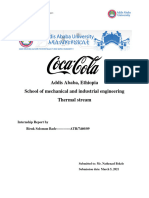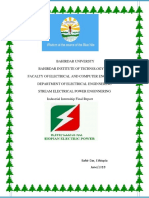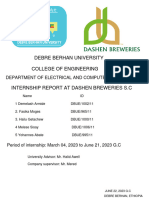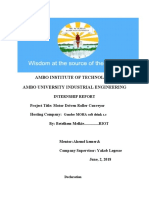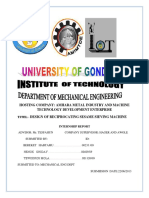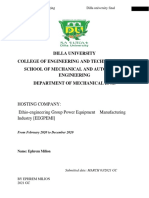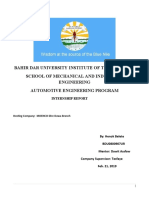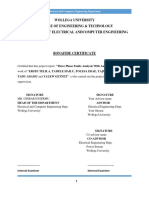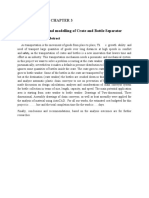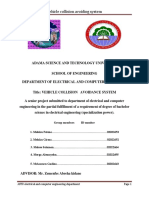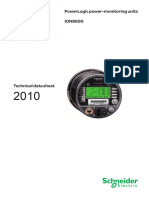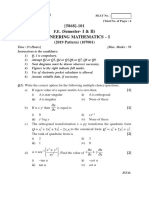Amhara Pipe Factory
Amhara Pipe Factory
Uploaded by
SileshCopyright:
Available Formats
Amhara Pipe Factory
Amhara Pipe Factory
Uploaded by
SileshOriginal Title
Copyright
Available Formats
Share this document
Did you find this document useful?
Is this content inappropriate?
Copyright:
Available Formats
Amhara Pipe Factory
Amhara Pipe Factory
Uploaded by
SileshCopyright:
Available Formats
AMHARA PIPE FACTORY INTERNSHIP REPORT
AMHARA PIPE FACTORY (APF)
INTERNSHIP REPORT
BY
BEREKET
HAKIMA
SILESH LAKE
ZEMEN BIYADGO
April, 2021 G.C Page 1 of 9
AMHARA PIPE FACTORY INTERNSHIP REPORT
Power House
Power house is a place where power is stored and distribute to the factory. 15kV is came from
the source and this is stepped down to 380V by delta star connected step down transformer.
There are five three phase transformers connected in parallel to step down this source. This
stepped down power enters to the main circuit board and then to the capacitor banks, which is
used to store, distribute and maintain the power factor.
These capacitor banks are merely grouping of several capacitors of the same rating. Capacitive
banks store energy when it is connected to a charging circuit and release that energy when
discharged. Capacitor banks are used to store electrical energy and condition the flow of that
energy. Increasing the number of capacitors will increase the capacity of energy that can be
stored on a single device.
Capacitor banks are also used for power factor correction. Let us discuss about power factor.
Power Factor
The power factor is defined as the ratio of the active power (P) and volt-amperes. The active
power is the real power which is assumed in an AC circuit, whereas volt-amperes is the apparent
power which is produced in the circuit when the waves of voltage or current are not in phase.
Equation (1) shows that the current is affected by the power factor. Hence, for a given power P
by the load, the current I, taken by the load varies inversely as the load power factor cosΦ. Thus,
a given load takes more current at a low power factor than it does at a high power factor.
Disadvantages of low power factor
April, 2021 G.C Page 2 of 9
AMHARA PIPE FACTORY INTERNSHIP REPORT
The undesirable effect of operating a low load at a low power factor is due to the large current
required for a low power factor. The important disadvantages of low power factor are
Higher current is required by the equipment, due to which the economic cost of the
equipment is increased.
At low power factor, the current is high which gives rise to high copper losses in the
system and therefore the efficiency of the system is reduced.
Higher current produced a large voltage drop in the apparatus. This results in the poor
voltage regulation.
Since both the capital and running cost are increased, the operation of the system at low power
factor (whether it is lagging or leading) is uneconomical from the supplier’s point of view.
Difference Between Active & Reactive Power
The most significant difference between the active and reactive power is that the active power is
the actual power which is dissipated in the circuit. Whereas, the reactive power is the useless
power which only flows between the source and load.
Definition of Active Power
The power which is dissipated or do the useful work in the circuit is known as the active power.
It is measured in watts or megawatts. The active power is denoted by the capital alphabet P. The
average value of power in the circuit is given by the expression.
Definition of Reactive Power
The reactive power moves between the source and load of the circuit. This power is not doing
any useful works on the load. Q represents the reactive power, and it is measured in VAR. The
reactive power is stored in the circuit, and it is discharged by the induction motor, transformer or
by solenoids.
Water Chiller
April, 2021 G.C Page 3 of 9
AMHARA PIPE FACTORY INTERNSHIP REPORT
Plastic pipe manufacturing processes require chilled water to cool the water tank down to the
proper temperature and furthermore to cool the output plastic products, which will pass through
the water tank, last to improve quality and decrease scrap.
Chilled water systems include both supply and return piping in a closed circuit. Water is cooled
by the chiller and “supplied” to cooling coils or heat exchangers, where it in turn cools air or a
process by absorbing energy. Thus warmed, the water is “returned” to the chiller to start the
process over again.
Chilled water systems are closed loop systems, which means they are sealed from the
atmosphere and do not need extensive chemical treatment to control contamination and
corrosion.
PVC Manufacture
Basically, PVC products are formed from raw PVC powder by a process of heat and pressure.
The production flows the following procedure.
Polymer and additives (1) are accurately weighed (2) and processed through the high speed
mixing (3) to blend the raw materials into a uniformly distributed dry blend mixture. At various
stages of the mixing process, the additives melt and progressively coat the PVC polymer
granules. After reaching the required temperature, the blend is automatically discharged into a
cooling chamber which rapidly reduces the temperature thereby allowing the blend to be
conveyed to intermediate storage (4) where even temperature and density consistency are
achieved.
The heart of the process, the extruder (5), has a temperature-controlled, zoned barrel in which
rotate precision “screws”. Modern extruder screws are complex devices, carefully designed with
April, 2021 G.C Page 4 of 9
AMHARA PIPE FACTORY INTERNSHIP REPORT
varying flights to control the compression and shear, developed in the material, during all stages
of the process.
The PVC dry blend is metered into the barrel and screws, which then convert the dry blend into
the required “melt” state, by heat, pressure and shear. During its passage along the screws, the
PVC passes through a number of zones that compress, homogenise and vent the melt stream. The
final zone increases the pressure to extrude the melt through the head and die set (6) which is
shaped according to the size of the pipe required and flow characteristics of the melt stream.
Once the pipe leaves the extrusion die, it is sized by passing through a precision sizing sleeve
with external vacuum. This is sufficient to harden the exterior layer of PVC and hold the pipe
diameter during final cooling in a controlled water cooling chambers (8).
The pipe is pulled through the sizing and cooling operations by the puller or haul-off (9) at a
constant speed. Speed control is very important when this equipment is used because the speed at
which the pipe is pulled will affect the wall thickness of the finished product. In the case of
rubber ring jointed pipe the haul-off is slowed down at appropriate intervals to thicken the pipe
in the area of the socket.
An in-line printer (10) marks the pipes at regular intervals, with identification according to size,
class, type, date, Standard number, and extruder number. An automatic cut-off saw (11) cuts the
pipe to the required length.
A belling machine forms a socket on the end of each length of pipe (12). There are two general
forms of socket. For rubber-ring jointed pipe, a collapsible mandrel is used, whereas a plain
mandrel is used for solvent jointed sockets. Rubber ring pipe requires a chamfer on the spigot,
which is executed either at the saw station or belling unit.
As an electrical engineer we use different materials and flow the required processes and control
methods to get the desired product. Those materials and control systems that we have seen in the
factory are:
Contactor
April, 2021 G.C Page 5 of 9
AMHARA PIPE FACTORY INTERNSHIP REPORT
A contactor is an electrically-controlled switch used for switching an electrical power circuit. A
contactor is typically controlled by a circuit which has a much lower power level than the
switched circuit, such as a 24-volt coil electromagnet controlling a 230-volt motor switch.
Contactor
It consists of three main parts they are
Coil
It provides a force which is required to close the contact. The coil is also named as an
electromagnet. An enclosure is used to safeguard the coil and contactor.
Enclosure
It acts like an insulator and protector, which protects the circuit form any electrical contact, dust,
oil, etc. They are made up of different materials like Nylon 6, Bakelite, Thermosetting plastic,
etc.
Contacts
The main function of this is that it carries the current to various parts of the circuit. There are
classified into contact springs, axillary contacts, and power contacts. Where each of the contacts
has its own functions, which is explained in principle of operation of the contactor.
Encoder
April, 2021 G.C Page 6 of 9
AMHARA PIPE FACTORY INTERNSHIP REPORT
An encoder is a device, circuit, transducer, software program, algorithm or person that converts
information from one format or code to another. The purpose of encoder is standardization,
speed, secrecy, security, or saving space by shrinking size. Encoders are combinational logic
circuits and they are exactly opposite of decoders. They accept one or more inputs and generate a
multi-bit output code. Here the pipe factory uses it for speed control.
Impedance
Impedance is a device used to minimize starting current. When motor starts, the starting current
is too high that may damage the entire system. So it should be minimizes. To do this we use
impedance.
DC Drive
Definition: The DC motor drive is a type of amplifier or power modulator that integrate between
the controller and a DC motor. It takes the low current and then converts it into a high current
which is appropriate for the motor. The DC motor drive also provides the high current torque,
400 % more than the rated continuous torque.
AC Drive
An AC drive is a device that is used to control the speed of an electric motor. The speed is
controlled by changing the frequency of the electrical supply to the motor. The types of motors
that ac drives control are normally operating at constant speed. Enabling the user to control the
speed of motor potentially gives him various benefits in terms of process control, system stress
and energy savings.
April, 2021 G.C Page 7 of 9
AMHARA PIPE FACTORY INTERNSHIP REPORT
AC drive control diagram
Sensors
Define a Sensor as an input device which provides an output (signal) with respect to a specific
physical quantity (input). It can also defined as a device that converts signals from one energy
domain to electrical domain.
The term “input device” in the definition of a Sensor means that it is part of a bigger system
which provides input to a main control system (like a Processor or a Microcontroller).
Sensors that we see in the factory are the following:
Proximity sensor
A Proximity Sensor is a non-contact type sensor that detects the presence of an object. Proximity
sensors are used across a broad range of industrial and manufacturing applications. They’re used
to sense the presence of objects or materials and then either initiate some action or simply flag
their presence or absence. Key to their operation is that they don’t require physical contact with
the target or object being sensed. This is why they’re often called non-contact sensors.
Thermocouple
April, 2021 G.C Page 8 of 9
AMHARA PIPE FACTORY INTERNSHIP REPORT
A thermocouple is an electrical device consisting of two dissimilar electrical conductors forming
an electrical junction. A thermocouple produces a temperature-dependent voltage as a result of
seebeck effect, and this voltage can be interpreted to measure temperature. Thermocouples are
widely used as temperature sensors.
Photo Sensor
Like proximity sensor photo sensor is a non-contact type sensor that detects the presence of an
object. This sensor detects any object but proximity sensor detects metals.
Water Level Sensor
Water level sensor is a sensor used to control the level of water in the water thank, which is used
for cooling. It has high and low level sensor. Low level sensor send message to fill the thank
when the water is low, while the high level sensor is used to stop the filling of water when the
thank is full.
April, 2021 G.C Page 9 of 9
You might also like
- A Project Submitted in Partial Fulfilment of The Requirement For The Awards ofDocument36 pagesA Project Submitted in Partial Fulfilment of The Requirement For The Awards ofHari Arts100% (1)
- EE-6 3-Phase AcDocument18 pagesEE-6 3-Phase AcZen Garcia100% (1)
- HD Final Report2Document39 pagesHD Final Report2Belayneh Tadesse100% (3)
- Smart Injera Baking System: Department ofDocument36 pagesSmart Injera Baking System: Department ofafomia100% (3)
- Final Report of Internship PDFDocument60 pagesFinal Report of Internship PDFSolomon Ferede84% (51)
- Sample Problems: T o N M AO AN RC RM AM TM TODocument11 pagesSample Problems: T o N M AO AN RC RM AM TM TONiño John Jayme100% (1)
- Internshipe Report On Amhara Pipe FactoryDocument45 pagesInternshipe Report On Amhara Pipe FactorySilesh100% (7)
- Coca-Cola Internship Report Final Biruk Solomon BadeDocument70 pagesCoca-Cola Internship Report Final Biruk Solomon BadebrookNo ratings yet
- RightDocument54 pagesRightBelayneh Tadesse100% (2)
- Final Tana Beles - pdf2222Document72 pagesFinal Tana Beles - pdf2222Tiruneh Yeneneh100% (1)
- Automatic BackingDocument65 pagesAutomatic Backingzelalem67% (6)
- Intern Report17Document100 pagesIntern Report17Negussie MeriedNo ratings yet
- 4 5974498159563377100Document44 pages4 5974498159563377100Ebrahim Ali100% (3)
- Ambo InternDocument63 pagesAmbo InternabduNo ratings yet
- Hosting Company: Amhara Metal Industry and Machine Technology Development Enterprise Design of Reciprocating Sesame Sieving MachineDocument68 pagesHosting Company: Amhara Metal Industry and Machine Technology Development Enterprise Design of Reciprocating Sesame Sieving MachineHenok GhidayNo ratings yet
- DireDocument59 pagesDireMesfin Belay100% (1)
- Internship Report On Belayab Cable Manufacturing PLC: DeclarationDocument47 pagesInternship Report On Belayab Cable Manufacturing PLC: DeclarationAdisu Zi100% (6)
- Dilla Unv Ethio-EngineeringDocument67 pagesDilla Unv Ethio-EngineeringFikadu100% (1)
- By Birhanu AlemuDocument62 pagesBy Birhanu AlemuBirhanu Alemu100% (2)
- Project (Repaired) Mulugeta and YalewDocument83 pagesProject (Repaired) Mulugeta and YalewSolomon Girma100% (3)
- Anbussa City Bus Service Enterprise HistoryDocument10 pagesAnbussa City Bus Service Enterprise HistorySeyfeAlemayehuNo ratings yet
- Hu Internship Final Report (Bereket Getnet)Document75 pagesHu Internship Final Report (Bereket Getnet)Bereket Getnet100% (1)
- Internship ReportDocument45 pagesInternship Reportbernabas100% (3)
- GUESH FINAL REPORT ON APF (Repaired) Alex PowerDocument40 pagesGUESH FINAL REPORT ON APF (Repaired) Alex PowerBelayneh Tadesse100% (3)
- Bahir Dar University Institute of TechnologyDocument27 pagesBahir Dar University Institute of TechnologyGadisa Abrahim100% (2)
- Wollo UniversityDocument58 pagesWollo Universityeyob fesha100% (2)
- Final Abdu ProjectDocument47 pagesFinal Abdu Projecttazeb Abebe100% (1)
- Adigrat University: CollegeDocument45 pagesAdigrat University: CollegeBelayneh Tadesse100% (4)
- Section: Student Nameid No-Marta Mayse Eng/R/305/11 Dawit Basene Eng/RDocument9 pagesSection: Student Nameid No-Marta Mayse Eng/R/305/11 Dawit Basene Eng/RMarta MayseNo ratings yet
- Bite PDFDocument60 pagesBite PDFolex67% (3)
- Beles Sugar Factory Internship Final Report-2-1Document80 pagesBeles Sugar Factory Internship Final Report-2-1GetinetNo ratings yet
- Final Thesis On 3phase Fault AnalysisDocument73 pagesFinal Thesis On 3phase Fault Analysisabel tibebuNo ratings yet
- Moha Internship ReportDocument56 pagesMoha Internship ReportAbdu LetifNo ratings yet
- B.G.I, Ethiopia Internship Report: Certificate/DeclarationDocument53 pagesB.G.I, Ethiopia Internship Report: Certificate/DeclarationNatnael Bereket100% (1)
- Zerihun TeshomeDocument51 pagesZerihun Teshomeetayhailu100% (2)
- Arba Minch University Electromechanical Engineering THESIS 2023Document48 pagesArba Minch University Electromechanical Engineering THESIS 2023Milkeessaa TarrafeeNo ratings yet
- Bahir-Dar University Bahir-Dar Institute of Technology Faculty of Chemical and Food Engineering Department of Chemical EngineeringDocument76 pagesBahir-Dar University Bahir-Dar Institute of Technology Faculty of Chemical and Food Engineering Department of Chemical Engineeringtazeb Abebe89% (9)
- Industrial Attachment Report 2Document41 pagesIndustrial Attachment Report 2Charles Odada88% (8)
- Bishoftu - Design of A Hydraulic LiftDocument63 pagesBishoftu - Design of A Hydraulic LiftAmanuelNo ratings yet
- Final Internship Report at Eabsc: DeclarationDocument13 pagesFinal Internship Report at Eabsc: DeclarationHaymanot Legesse50% (4)
- 4 5924833094782682822Document75 pages4 5924833094782682822kidanemariam teseraNo ratings yet
- TENA WATER PLC. Internship ReportDocument73 pagesTENA WATER PLC. Internship ReportMohammed Abrar100% (1)
- Auto Injera Making MachineDocument1 pageAuto Injera Making MachineTSEDEKE100% (3)
- Abadi TesfeuDocument44 pagesAbadi TesfeuBelayneh Tadesse100% (3)
- Intership PresentationDocument61 pagesIntership PresentationAbdulrazzak Aman75% (4)
- Bekele GaddisaDocument101 pagesBekele GaddisaAhmed Abo RashedNo ratings yet
- Agmas DashenDocument55 pagesAgmas DashenDegsew MesafintNo ratings yet
- Internship ReportDocument28 pagesInternship Reportabenezer denekeNo ratings yet
- ADMAS UNIVERSITY FINAL ThesisDocument52 pagesADMAS UNIVERSITY FINAL ThesisWeldu GebruNo ratings yet
- Eyu Internship ReportDocument12 pagesEyu Internship ReportAbel Lema100% (2)
- MAN3 VVVVVVVVVVVVVDocument57 pagesMAN3 VVVVVVVVVVVVVBirbirsa BetieNo ratings yet
- Instituteof Technology: Hawassa UniversityDocument25 pagesInstituteof Technology: Hawassa UniversityTadesse Abadi100% (2)
- Ethiopia Solar Energy Target Market AnalysisDocument37 pagesEthiopia Solar Energy Target Market AnalysismhhdNo ratings yet
- Ggggggggmmmfffmmnew PDFDocument49 pagesGgggggggmmmfffmmnew PDFBelayneh TadesseNo ratings yet
- Addis Ababa Science and Technology University: College of Biological and Chemical EngineeringDocument74 pagesAddis Ababa Science and Technology University: College of Biological and Chemical EngineeringMULAT DEGAREGENo ratings yet
- Tamru Desalegn and Adugna NigisaDocument180 pagesTamru Desalegn and Adugna Nigisasamuel fekade80% (5)
- PHD Synopsis Presentation1Document23 pagesPHD Synopsis Presentation1vijay patilNo ratings yet
- Introducton 1.1 Overview:: Power Transformer Protection Using Microcontroller-Based RelayDocument51 pagesIntroducton 1.1 Overview:: Power Transformer Protection Using Microcontroller-Based RelayManoj NagarajanNo ratings yet
- Home GRIDDocument5 pagesHome GRIDramoradoNo ratings yet
- Cell Cycle RDocument11 pagesCell Cycle RMirko Ronald Grageda ZegarraNo ratings yet
- Electro Report Group 3Document6 pagesElectro Report Group 3John Steven DelimaNo ratings yet
- Micro Hydro Electricity BasicsDocument13 pagesMicro Hydro Electricity Basicssebascian100% (1)
- EQuationDocument1 pageEQuationSileshNo ratings yet
- Chapter 3-Fuzzy Logic ControlDocument67 pagesChapter 3-Fuzzy Logic ControlSilesh100% (1)
- Introduction To Microwave Circuits & SystemsDocument15 pagesIntroduction To Microwave Circuits & SystemsSilesh100% (1)
- Application Letter: To: Industrial Parks Development Corporation Subject: Job Opportunity - Junior ConsultantDocument5 pagesApplication Letter: To: Industrial Parks Development Corporation Subject: Job Opportunity - Junior ConsultantSileshNo ratings yet
- Aksum University Colleg of Engineering and TechnologyDocument56 pagesAksum University Colleg of Engineering and TechnologySileshNo ratings yet
- Analysis and Modelling of Crate and Bottle Separator: DesignDocument27 pagesAnalysis and Modelling of Crate and Bottle Separator: DesignSileshNo ratings yet
- EEU Exam Questions: Part I ChoiceDocument4 pagesEEU Exam Questions: Part I ChoiceSilesh95% (20)
- Main DTMF RobotDocument37 pagesMain DTMF RobotSileshNo ratings yet
- Standard Format For Final Year Project Report For ECE DepartmentDocument11 pagesStandard Format For Final Year Project Report For ECE DepartmentSileshNo ratings yet
- University of Gondar Institutes of Technology Department of Electrical and Computer EngineeringDocument16 pagesUniversity of Gondar Institutes of Technology Department of Electrical and Computer EngineeringSileshNo ratings yet
- Adigrat University: Advisor Name: Ins: G/Medhin GDocument35 pagesAdigrat University: Advisor Name: Ins: G/Medhin GSileshNo ratings yet
- Chapter One 1. Background of Amhara Pipe Factory 1.1 Brief History (Introduction)Document15 pagesChapter One 1. Background of Amhara Pipe Factory 1.1 Brief History (Introduction)Silesh100% (1)
- University of Gondar: Entrepreneurship Feasibility Study and Business PlanDocument27 pagesUniversity of Gondar: Entrepreneurship Feasibility Study and Business PlanSileshNo ratings yet
- Smart Generator Monitoring SystemDocument41 pagesSmart Generator Monitoring SystemSilesh100% (3)
- 5th Final Thesis ProjectDocument61 pages5th Final Thesis ProjectSileshNo ratings yet
- TS9065 Measuring Electrical Power With Labview and CompactRIODocument42 pagesTS9065 Measuring Electrical Power With Labview and CompactRIOWardencasianAlanisNo ratings yet
- NR10 1-Fazovy Elektromer Priame Do 100ADocument4 pagesNR10 1-Fazovy Elektromer Priame Do 100Aslecka2658No ratings yet
- VidyadhariDocument5 pagesVidyadharividyadhari12No ratings yet
- PSS Lab Manual - SsitDocument78 pagesPSS Lab Manual - Ssitshriammu88% (8)
- EM6400RegMap V01.01.02 PDFDocument12 pagesEM6400RegMap V01.01.02 PDFvinay panchalNo ratings yet
- Ijert Ijert: Modeling and Simulation of STATCOMDocument4 pagesIjert Ijert: Modeling and Simulation of STATCOMAbdallah AmroNo ratings yet
- Mikro PFCR ExplanationDocument31 pagesMikro PFCR Explanationyschan30No ratings yet
- 8600 WattmeterDocument11 pages8600 WattmeterYosep GunawanNo ratings yet
- Pioneer - A 30 K - A 30 S - A 20 K - A 20 S - A 20 - A 10 K - A 10 S - rrv4297 - Integrated - Amplifier PDFDocument57 pagesPioneer - A 30 K - A 30 S - A 20 K - A 20 S - A 20 - A 10 K - A 10 S - rrv4297 - Integrated - Amplifier PDFJairo Huapaya AullaNo ratings yet
- Book 4Document197 pagesBook 4fgdfgdfNo ratings yet
- DELTA IA-SI DPM C EN 20161117 WebDocument12 pagesDELTA IA-SI DPM C EN 20161117 WebchichialinNo ratings yet
- Power Plant Controller-Putting The Power Back Into The Hands of The DeveloperDocument6 pagesPower Plant Controller-Putting The Power Back Into The Hands of The DeveloperSgurr EnergyNo ratings yet
- Schneider - Power Factor Correction and Harmonic Filtering (B - 954 - 503 - 439)Document82 pagesSchneider - Power Factor Correction and Harmonic Filtering (B - 954 - 503 - 439)Ieremeiov Vladimir100% (1)
- CHAPTER 2 4.0 Three Phase SystemsDocument41 pagesCHAPTER 2 4.0 Three Phase SystemsMUHAMMAD ALIFF DANIAL RAZMINo ratings yet
- Improvement of Power Quality Using PQ-theory Shunt-Active Power FilterDocument6 pagesImprovement of Power Quality Using PQ-theory Shunt-Active Power FilterPradnya TantarpaleNo ratings yet
- Basic Power Factor CorrectionDocument52 pagesBasic Power Factor Correctiondto_otb100% (2)
- APFCDocument26 pagesAPFCPooja Ban100% (1)
- VOLTS/OHMS AMPERES Voltage Across Resistance Causes CurrentDocument12 pagesVOLTS/OHMS AMPERES Voltage Across Resistance Causes CurrentUtpal Chandra DashNo ratings yet
- C300B Manual EN 2019-06Document17 pagesC300B Manual EN 2019-06Ade100% (1)
- E PDFDocument178 pagesE PDFVasu IyerNo ratings yet
- (Semester-I & II) Engineering Mathematics - I: Time: 2 Hours) (Max. Marks: 70 Instructions To The CandidatesDocument66 pages(Semester-I & II) Engineering Mathematics - I: Time: 2 Hours) (Max. Marks: 70 Instructions To The CandidatesOnkar LondheNo ratings yet
- STP60 10 Den1650 V23WDocument4 pagesSTP60 10 Den1650 V23WSunil SinghNo ratings yet
- Power Quality Lecture Notes Sridhar Sridhar-JntuhDocument171 pagesPower Quality Lecture Notes Sridhar Sridhar-JntuhSingam Sridhar81% (16)
- Power ElectronicsDocument451 pagesPower ElectronicsSteven Seng100% (2)
- HGM7110VS Genset Controller User Manual: Zhengzhou Smartgen Technology Co.,LtdDocument54 pagesHGM7110VS Genset Controller User Manual: Zhengzhou Smartgen Technology Co.,LtdNeville GibbsNo ratings yet
- Manual Electric MotorDocument17 pagesManual Electric Motorm,.100% (1)
- A Voltage-Controlled DSTATCOM For Power-Quality Improvement PDFDocument9 pagesA Voltage-Controlled DSTATCOM For Power-Quality Improvement PDFChristian EmenikeNo ratings yet
- Voltage Sag and Anti IslandingDocument10 pagesVoltage Sag and Anti IslandingDramebaaz SandeepNo ratings yet







